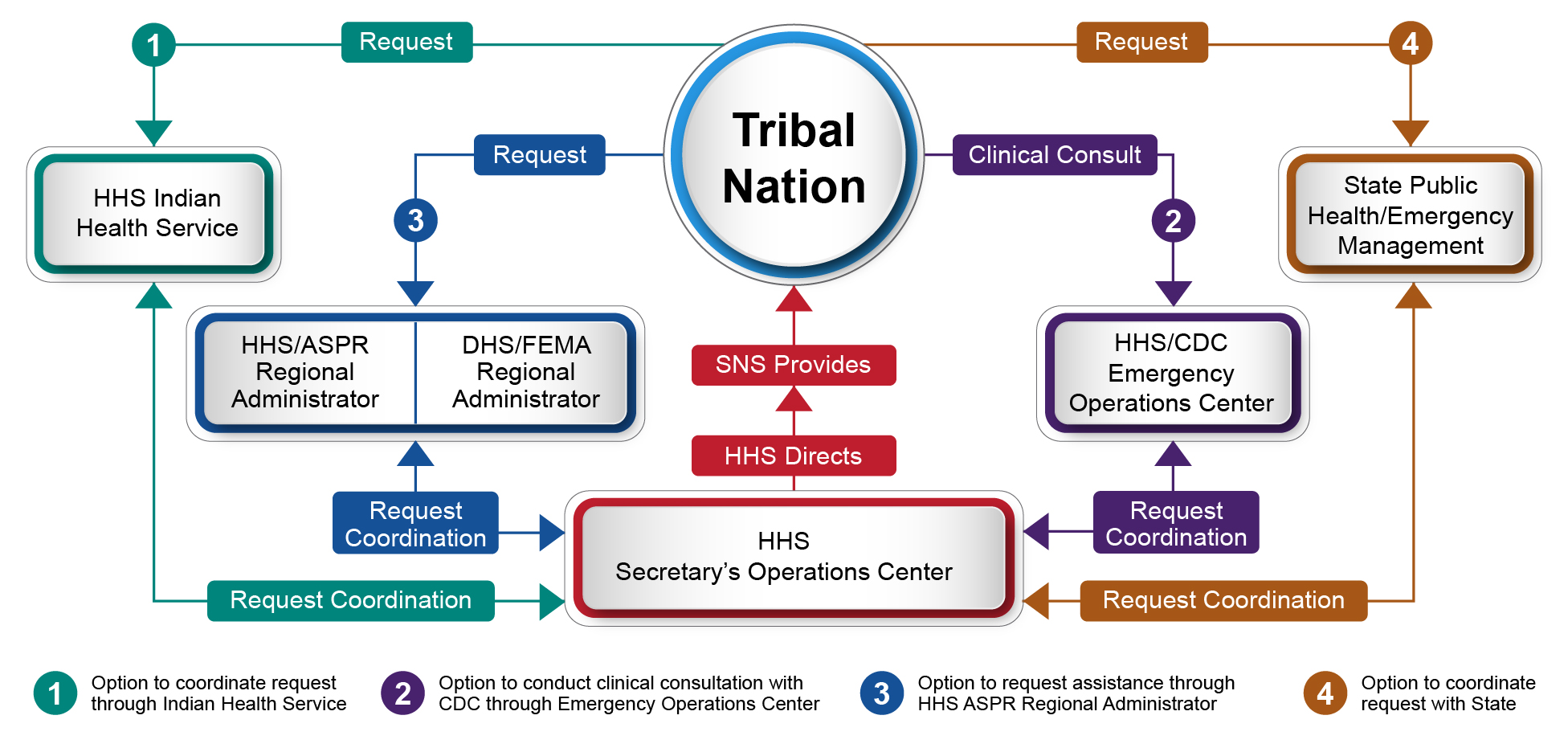Tribal Pathways for Accessing Emergency Medical Countermeasures
In January 2021, President Biden issued
Executive Order 14001: Sustainable Public Health Supply Chain, which called for solutions to secure supplies essential for responding to the COVID-19 pandemic and future public health emergencies. This executive order led to the establishment of pathways for federally recognized tribal governments and Urban Indian Organizations (UIOs) to access the Strategic National Stockpile (SNS) and other federal public health emergency resources.
For Tribal Nations:
Tribal nations have several avenues to access to stockpiled medical countermeasures, and they may use multiple pathways simultaneously, ensuring a comprehensive response to emergencies. Coordination among relevant agencies and stakeholders is essential to avoid duplication of efforts, streamline support from the U.S. government, and ensure the availability of resources for native communities to respond to public health emergencies. The pathways are as follows:
-
Indian Health Service (IHS): Tribal nations can request access to SNS or other federal response supplies through the Emergency Management Point of Contact (EMPOC) for their IHS Area Office. When IHS receives a request for SNS assets from a tribal nation, IHS will work internally to determine if the IHS National Supply Service Center (NSSC) can fulfill the request, or whether it should be elevated as a request to SNS via the HHS Secretary’s Operation Center (SOC).
-
Centers for Disease Control and Prevention (CDC): Tribal nations can seek guidance on clinical or public health issues through direct consultation with CDC experts. Based on these consultations, requests for SNS assets and other resources can be made through the CDC Emergency Operations Center (EOC).
-
Federal Regional Administrators (ASPR and FEMA): Tribal nations can directly request assistance from federal regional administrators, particularly during large-scale emergencies. ASPR and FEMA regional offices play a key role in coordinating responses and providing support to tribal nations.
-
States: Tribal nations can leverage existing relationships with states to access SNS assets and federal resources. This involves working with state public health and emergency management authorities to initiate requests for support.

Tribal nations can seek technical assistance from various sources, ASPR regional administrators, IHS representatives, the Department of Health and Human Services Secretary's Operations Center, the CDC EOC, the SNS Operations Center and state agencies.
For Urban Indian Organizations (UIOs):
UIOs, as nonprofit organizations providing health care services to urban Indian beneficiaries, have limited avenues for requesting federal resources. Unlike tribal nations, UIOs do not have the authority to make direct requests for federal assistance from FEMA or ASPR regional administrators.
-
IHS: Like tribal nations, UIOs can request access to SNS medicines, supplies and equipment through the EMPOC for their IHS Area Office.. The process involves initiating requests through IHS, which then flow through relevant channels to ASPR and the SNS.
-
States: UIOs typically rely on their relationships with states to access federal resources. Requests for SNS assets and other support are made through state public health and emergency management authorities.
-
CDC: UIO clinicians can seek guidance from CDC experts on clinical or public health issues. However, UIOs cannot directly request SNS assets through this process and must coordinate requests through state authorities or IHS.

More detailed information on the process for defining tribal pathways to access emergency medicines, supplies and equipment, including feedback gathered from consultations with tribal nations and UIOs, is available in the
Strategy for Improving Access to Federal Resources During a Public Health Emergency Response for Federally Recognized Tribal Governments, Indian Health Service Health Care Providers, Tribal Health Authorities, and Urban Indian Organizations.

